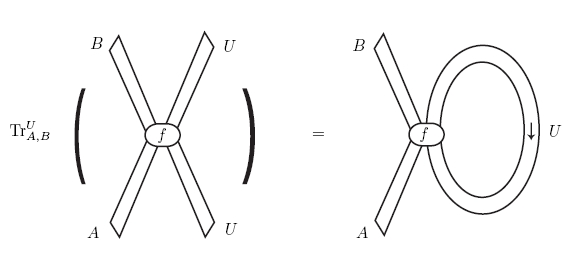Traces in Ottawa
Posted by John Baez
If you’re interested in logic, category theory, and diagrams, you’ll like this workshop:
- Recent advances in category theory and logic: applications of traces to algebra, analysis and categorical logic, April 28-30, 2007, University of Ottawa. Organized by Phil Scott, Rick Blute, and Pieter Hofstra.
What’s a trace, you ask? Read on…
Here’s the conference announcement:
The abstract theory of traces has had a fundamental impact on a variety of fields within mathematics. These range from functional analysis and noncommutative geometry to topology and knot theory, and more recently to logic and theoretical computer science. The theory of traced monoidal categories, due to Joyal, Street and Verity, is an attempt to unify various notions of trace that occur in these diverse branches of mathematics. More recent developments include several theories of partial traces in monoidal categories.
The Logic and Foundations of Computing Group at the University of Ottawa, with funding from the Fields Institute, is proud to host a workshop to explore these topics. The purpose of this workshop is to bring together researchers in these fields to look for common developments, models, and applications of trace theory. Among the applications are various notions of parametrized traces arising in operator algebras, in the theory of feedback and recursion in theoretical computer science, in braid closure in knot theory, and in dynamics of proofs as expressed by Linear Logic and the Geometry of Interaction.
Some invited speakers include:
- Samson Abramsky (Oxford)
- Robin Cockett (Calgary)
- Andre Joyal (UQAM)
- Louis Kauffman (Illinois)
- Mathias Neufang (Carleton)
- Timothy Porter (Bangor)
We will be announcing further speakers shortly. This is intended to be a workshop, with student participation in mind, including introductory lectures. We will have some funding for student travel and accommodation. Students interested in receiving financial aid should contact the organizers by January 30th.
Anyone interested in attending or contributing a talk should contact us by the same date.
You may know about the trace of square matrix, which is a number: just the sum of its diagonal entries. In index notation:
where the Einstein summation convention says we sum over the repeated inde .
In quantum physics we often do something more general: we take the ‘partial trace’ of a density matrix describing the state of a two-part system, to get the state of one of the parts. Mathematically, the partial trace of a linear operator
is an operator
given by
where runs over a basis of the vector space .
In terms of diagrams, the partial trace looks like this:
Time in this diagram goes up, as in traditional Feynman diagrams. If we’re talking about linear operators, the loop stands for the summation over the repeated index . But these diagrammatic methods are much more general: we can define partial traces in a large class of monoidal categories, including all compact symmetric monoidal categories — but also others! For example, in logic and computer science, partial traces are used to describe ‘fixed points’.
The picture above is from a talk by Paul-André Melliès, which explains some of the uses of traces in logic. Click on it and learn more!


Re: Traces in Ottawa
I have mentioned/asked the following before, but here in the context of general traces it might be the right point to mention/ask it again:
In what should probably be called “globular extended 2-dimensional quantum field theory” we need partial traces in braided monoidal categories to do things like this:
The dashed boxes are supposed to indicate a 2-morphism in a 2-category. The full lines inside the boxes are supposed to denote the Poincaré-dual “string diagram” notation of that same globular 2-morphism.
Being a 2-globe, the 2-morphism itself always has the topology of a disk.
But I might want to think of this 2-morphism of having the topology of a trinion: a sphere with three disks cut out.
This can be thought of as obtained from the shown disk-like bigon by identifying all outer parallel dashed lines.
What does such a kind of identification mean operationally? If we compare with John’s diagram for any partial trace above, we see that it should mean that we somehow join the dual “string tangles” that run perpendicular to the edges that are to be identified.
In other words: that we take particl traces at the ingoing and outgoing edges that are to be identified.
In order to do that, though, as the picture makes clear, we need to braid past some other strands.
The diagram above depicts the right result.
Is there a general theory of generalized traces in a general class of categories that would be applicable to this context and reproduce the above idea?
I’d be grateful for any pointers to the literature.